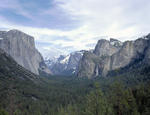National Park Service Press ReleaseFor Immediate Release:
September 30, 2010
Contact(s): Jeffrey Olson, NPS, 202-208-6843, jeffrey_olson@nps.gov, Kelly Humphries, NASA, 281-483-5111, Kelly.o.humphries@nasa.gov, Stephanie Schierholz, NASA, 202-358-1100, stephanie.schierholz@nasa.gov
Washington, DC – Plan your next camp out for a national park and you might spot one of America’s gems of the night sky – the International Space Station – from one of its jewels on the ground.
Because the space station is more spectacular away from skyline clutter and light pollution, NASA and the National Park Service have partnered to share information with park visitors about where and when to look up.
National Park Service Director Jon Jarvis said, "The night sky is one of many spectacular resources national park visitors enjoy. Coordinating park locations with the space station flight schedule gives visitors another opportunity to reflect on human connections with the world and beyond."
Sightings depend on lighting, weather conditions and the station’s location as it orbits 200 miles above Earth at 17,500 mph. With the help of the Park Service, NASA recently imported the coordinates of 507 locations, including national parks and seashores, historic sites, monuments, and wild and scenic rivers. The station’s Mission Control Center at NASA’s Johnson Space Center in Houston uses these locations and the orbital path of the space station to predict times when people can see the station zoom across the sky.
"The space station is an international treasure, the size of a football field, and an inspiring sight in its own right flying through the sky at five miles per second," said Mike Suffredini, International Space Station program manager. "But I can't imagine a better way to share the experience with family and friends than during a trip to one of our national parks, where the stars seem to shine brighter whether they're natural or man-made."
Sighting predictions are available on NASA's SkyWatch website, via the agency's new mobile website, and NASA iPhone and iPad applications. Many park rangers who present night sky programs and park event calendars also will have the information available for park visitors.
"It's a good idea to check the sighting opportunities ahead of time," said Chad Moore, a scientist with the National Park Service night sky program. "Many remote national parks, which offer the best night sky conditions, have limited Internet or cell phone coverage."
The announcement of the collaboration between NASA and the National Park Service coincides with sighting opportunities on several parks' anniversaries. On Friday, Oct. 1, the 120th anniversary of Yosemite National Park, the station will pass overhead at 5:03 a.m. PST. On Oct. 2, the station will pass over Sequoia National Park at 5:29 a.m. PST and Kings Canyon National Park at 5:30 a.m. PST on the parks' 120th anniversaries. Oct. 2 is also the 42nd anniversary of Redwood National Park, which the station will fly over at 5:29 a.m. PST.
The space station usually appears over the western horizon and disappears over the eastern horizon in a matter of minutes. The best time to observe the station is near dawn or dusk, when the viewer is in near-darkness, and the passing station continues to reflect light from the rising or setting sun.
For detailed sightings information, please visit http://spaceflight.nasa.gov/realdata/sightings/.
For more information about the International Space Station, please visit http://www.nasa.gov/station/.
National Park Service and NASA offer space station sightings
All posts are those of the individual authors and the owner
of this site does not endorse them. Content should be considered opinion
and not fact until verified independently.
Sorry, only registered users may post in this forum.


